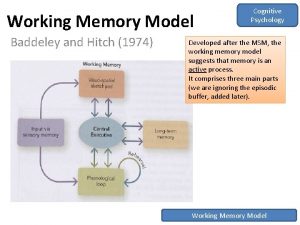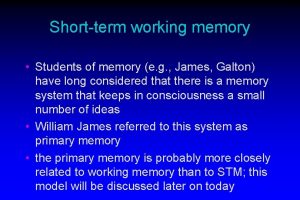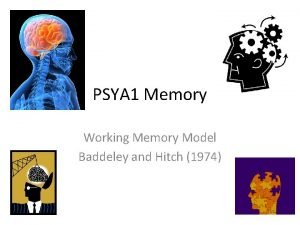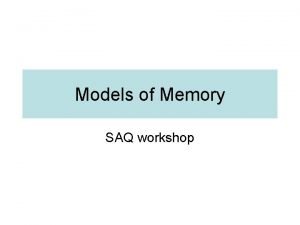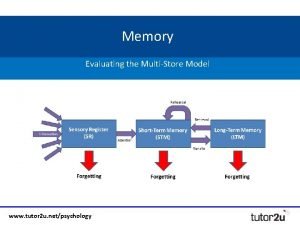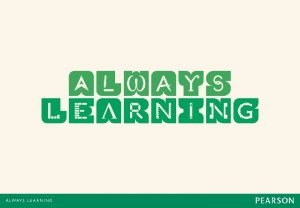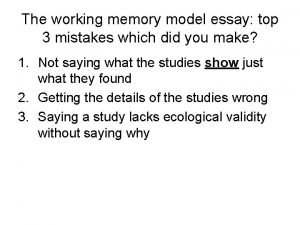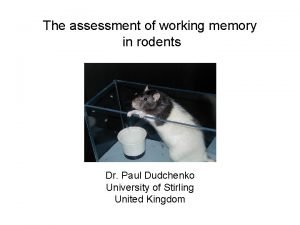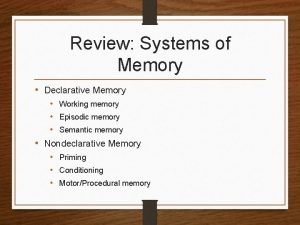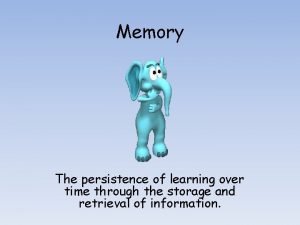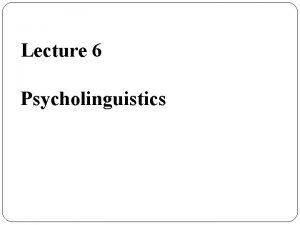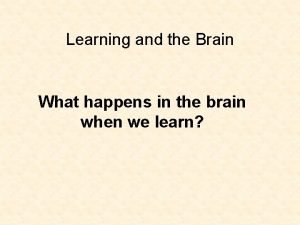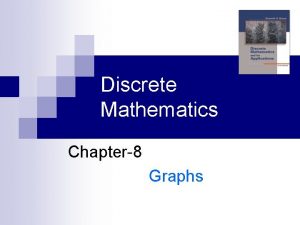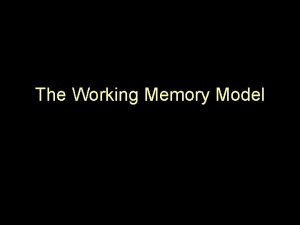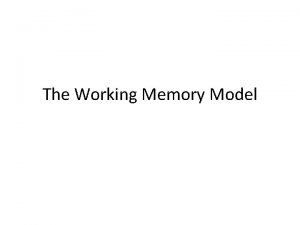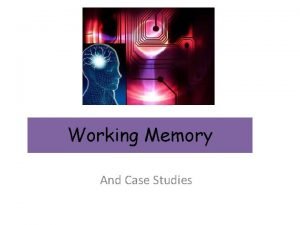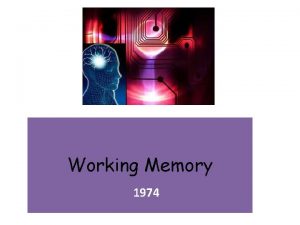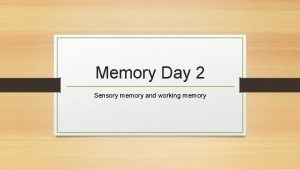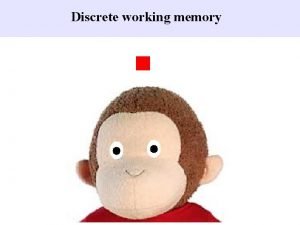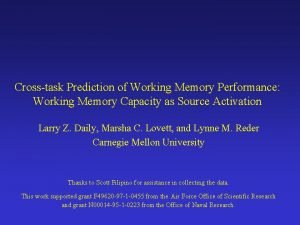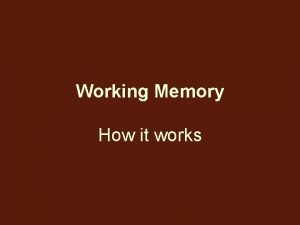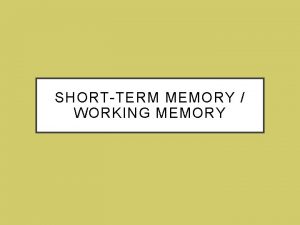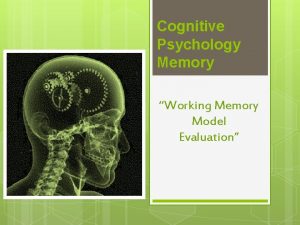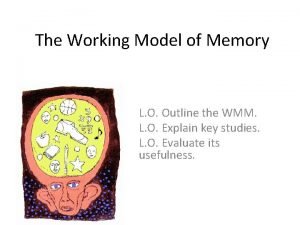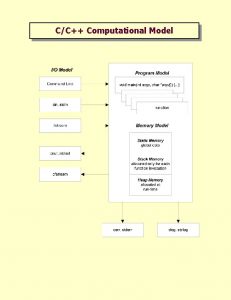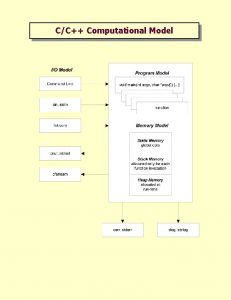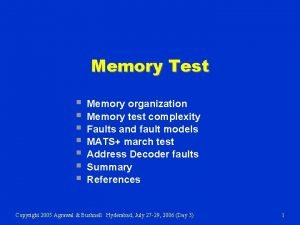The Working Memory Model Outline the Model AO



































- Slides: 35

The Working Memory Model Outline the Model (AO 1) Apply the Model (AO 2) Evaluate the Model (AO 3)

Deadline for Half Term HW has passed!

Why a new Model? Psychologists realised that it is unlikely that the STM is a static (unmoving) store. It is now proposed that the STM is a ‘working’ memory store with processes taking place within it. Baddeley and Hitch 1974 Atkinson and Shiffrin 1968

‘You can’t do too many things at once. . ’ What relevance does this advert have for the WMM topic? http: //www. youtube. com/watch? v =Bul 7 NAtna. QA

Who Am I? In turns, take a key term from the deck. Don’t look at it. VS VS Hold it in front of your forehead. You may ask 3 questions only. Guess they key term. For each term guessed correctly- 1 point.

Key Terms Environmental Stimuli Central Executive Visuospatial Sketchpad Phonological Loop Inner Scribe Articulatory Loop Visual Cache Phonological Store Episodic Buffer

How do we even know these separate systems exist? How could we test this idea?

Baddeley & Hitch (1976) Dual Task Method Aim: To investigate the existence of separate stores within the Short. Term Memory. Procedure: Participants were asked to complete two tasks that would either; Use the visuo-spatial sketchpad and the phonological loop at the same time Track a spot of light whilst singing happy birthday Use only the Visuospatial sketchpad Track a spot of light whilst mentally imagining a capital ‘F’ and move round the edge of the letter classifying the angles as either belonging to its top or bottom.


F

F

F






Findings: PPs had difficulty completing the two visual tasks, but not the visual task and the verbal task. Conclusion: This suggests that there are two stores within STM because when completing two visual tasks they compete for the limited capacity of the V. S. S. Baddeley & Hitch (1976) Dual Task Method

Anything wrong with this method? Baddeley & Hitch (1976) Dual Task Method Anything right with this method?

Complete Study Summary

5 minutes silently AO 2 Application Claire can search through family photos on her laptop and listen to music at the same time. However, she finds it difficult to read her e-mails when talking to a friend on the phone. Use your knowledge of the working memory model to explain why Claire is able to perform the first two tasks at the same time, but finds it difficult to perform the second two tasks at the same time. (Total 4 marks)

Peer Mark AO 2 Application AO 1=2 Credit knowledge / identification of each store (not episodic buffer); the idea that two tasks using separate stores can be performed simultaneously; performing two tasks that involve the same store impairs performance. Credit reference to limited capacity. AO 2=2 For full credit answers must refer to both sets of tasks. Possible answer: Claire can search for photos and listen to music as these tasks involve different sub-systems in working memory (1) – the visuo-spatial sketch / scratch pad and the articulatory / phonological loop / store / primary acoustic store (1). Claire finds it difficult to read her e-mails and talk on the phone as these tasks involve the same store (1) – the articulatory / phonological loop / store / primary acoustic store (1).

P- One strength of the WMM is that it has strong supporting evidence. E- Baddeley 1976 found that… (findings) AO 3 Supporting Evidence E- This supports the WMM because… (conclusions) L- on the other hand such research should be treated with caution because… (issues with Lab experiments- in Context!)

Working Memory in Chimpanzees https: //www. youtube. com/watch? v=zs. XP 8 qe FF 6 A This is an interesting and slightly unsettling video about WMM. It turns out that they are superior to humans on some working memory tasks! From your knowledge of the working memory model, can you identify the working memory task the chimps are carrying out?

AO 3 - Does the model offer a full explanation of human memory? P- One weakness of the WMM is that it doesn’t account effectively for ‘musical memory’. E- It would appear that we are able to for example, speak whilst also processing music. E- This is an issue because according to the WMM, these should compete for space in the P. L. therefore one would be impaired but it isn’t. L- Therefore it is likely that whilst more detailed that the MSM, it is still limited in explaining all of short term memory.

AO 3 - Does this model have real life application? P- One strength of the WMM is it has real life application. E- For example, the model has helped us to understand Dyslexia. Those with Dyslexia struggle to hold sounds from letters in the articulatory loop which makes it hard for them to read. E- This can explain why they are bright, yet written work does not show evidence it. L- This has been useful in offering education support to young people. https: //www. youtube. com/watch? v=a. Jo. MGUQFj Ws&feature=youtu. be

Writing AO 1 HW Knowledge Understanding Writing frame Mark scheme Extension- other AO 2 questions.

Quick quiz: Draw the right symbol! 2. How many components does the STM involve? … Three Two Four

Quick quiz: Draw the right symbol! 3. The ‘inner scribe’ is in the… Phonological store Phonological loop Visuo Spatial Sketchpad

Quick quiz: Draw the right symbol! 4. The ‘Phonological Store’ is in the… Central Executive Phonological loop Articulatory control process

Quick quiz: Draw the right symbol! 5. The ‘Phonological Store’ and ‘Articulatory Control’ make up the… Phonological store Phonological loop Articulatory control process

Quick quiz: Draw the right symbol! 6. The ‘delegator’ of incoming information is the… Central executive Phonological loop Visuo-spatial sketch-pad

Quick quiz: Draw the right symbol! 7. The central executive delegates to 2… . . . Other memory stores . . . other delegators . . . Slave systems

Quick quiz: Draw the right symbol! 8. Research evidence tends to involve… Looking at the success of participant’s performance in various ‘Dual’ task activities Looking at the success of participant’s performance in various ‘Mono’ task activities Looking at the success of participant’s performance in various ‘distractor’ task activities

Phonological loop: The word length effect Baddeley, (1975) Aim: To investigate the existence of the Phonological Loop in the WMM (STM). Procedure: Summary of study: PS shown everyday words briefly, and asked participants for serial recall (written). Words were either mono or poly syllabic. Condition 1: 5 monosyllabic words Condition 2: 5 polysyllabic words Findings: better recall in condition 1 Conclusion: The phonological loop plays a role in the STM, as the capacity is not determined by items but by sound- the time it takes to say a word. Identify the INDEPENDENT VARIABLE: Word length (2 levels) Identify the DEPENDENT VARIABLE: Recall Identify VARABLES TO CONTROL: Methodological issues: are longer words simply less familiar? Ethical issues: consent and debrief
 Which memory is the actual working memory?
Which memory is the actual working memory? Working memory model
Working memory model Slave systems working memory model
Slave systems working memory model Working memory model
Working memory model Saq 1
Saq 1 What is the multistore model
What is the multistore model Hard work and smart work
Hard work and smart work Hot and cold forming
Hot and cold forming Hot working and cold working difference
Hot working and cold working difference Machining operations
Machining operations Pengerjaan panas dan dingin
Pengerjaan panas dan dingin Automated working memory assessment
Automated working memory assessment Working memory essay
Working memory essay Working memory
Working memory Working memory
Working memory What is the persistence of learning over time
What is the persistence of learning over time Drc model of reading
Drc model of reading Working memory
Working memory Connected simple graph
Connected simple graph Semantic memory
Semantic memory Implicit explicit memory
Implicit explicit memory Long term memory vs short term memory
Long term memory vs short term memory Internal memory and external memory
Internal memory and external memory Primary memory and secondary memory
Primary memory and secondary memory Logical address
Logical address Page fault
Page fault Virtual memory in memory hierarchy consists of
Virtual memory in memory hierarchy consists of Eidetic memory vs iconic memory
Eidetic memory vs iconic memory Symmetric shared memory architecture
Symmetric shared memory architecture Quote sandwich
Quote sandwich Hát kết hợp bộ gõ cơ thể
Hát kết hợp bộ gõ cơ thể Lp html
Lp html Bổ thể
Bổ thể Tỉ lệ cơ thể trẻ em
Tỉ lệ cơ thể trẻ em Gấu đi như thế nào
Gấu đi như thế nào Chụp phim tư thế worms-breton
Chụp phim tư thế worms-breton

